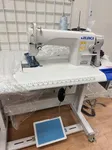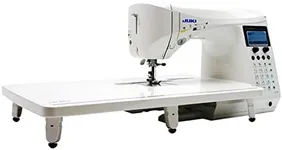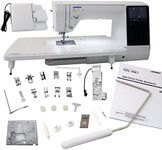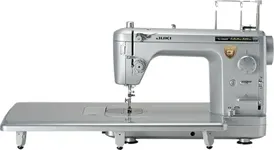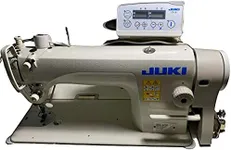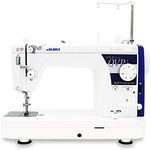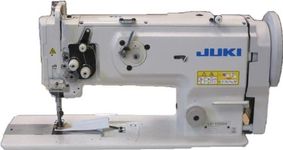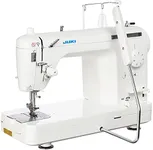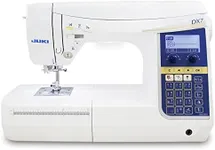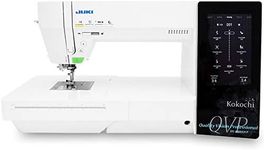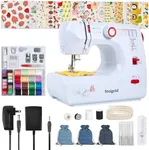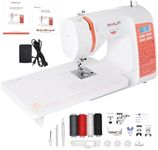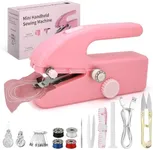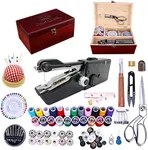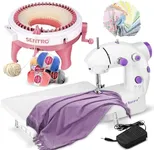Buying Guide for the Best Juki Sewing Machines
Choosing the right sewing machine can make a huge difference in both your enjoyment and the quality of your sewing projects. Juki is a reputable brand renowned for its durability and high-quality performance, particularly favored by both hobbyists and professionals. Before making your decision, it's important to start by thinking about what kinds of sewing projects you plan to tackle (like quilting, garment construction, or heavy-duty work), how often you'll use the machine, and what features will make your sewing easier and more enjoyable. By understanding the key specifications, you’ll be able to match a Juki sewing machine to your unique needs.Stitch Types and NumberStitch types refer to the different kinds of stitches a sewing machine can perform, ranging from basic straight and zigzag stitches to decorative and specialty stitches. The number and types of stitches are important because they determine the machine's versatility. Generally, basic machines have fewer stitch options and are well-suited for simple hemming or construction, while more advanced machines offer a broad range of stitches suitable for decorative or specialized work such as quilting or embroidery. When deciding, think about your most common projects—if you mainly sew clothes or items that only require a few stitches, a simpler machine is plenty. If you enjoy crafting or plan to try many techniques, more stitch options give you greater creative flexibility.
Computerized vs. Mechanical OperationJuki offers both computerized and mechanical sewing machines. Computerized machines feature electronic controls for stitch selection, speed adjustment, and sometimes automatic thread cutting, making them user-friendly with added convenience and precision. Mechanical machines, on the other hand, use manual dials and levers for adjustments and tend to be simpler and sturdy. If you prefer straightforward operation with minimal maintenance, mechanical may suit you. If accuracy, additional features, or ease of use appeals to you, especially if you sew frequently or tackle complex projects, consider a computerized option.
Speed (Stitches Per Minute)Speed in sewing machines is measured by stitches per minute (SPM), indicating how fast the machine can sew. Higher speeds are beneficial for large projects, production work, or experienced users who need efficiency, while lower speeds offer greater control, especially for beginners or for tasks that require precision. Machines can range from about 600 SPM for basic models to over 1,500 SPM for advanced, industrial-style machines. If you’re just starting, a moderate speed allows you to learn comfortably; experienced users or those working on bulk projects might value higher speeds.
Needle Position and AdjustmentThis feature describes how many positions the needle can be set to (such as left, center, or right) and whether it can be adjusted for precise seam allowance or specialty techniques like topstitching or zipper insertion. Flexible needle positioning gives you more control and allows for a wider variety of sewing tasks. If your projects often require sewing close to edges or using special attachments, look for machines with multiple needle positions. For straightforward construction, fewer positions may suffice.
Automatic Needle Threader and Thread CuttingAn automatic needle threader threads the sewing needle for you, while an automatic thread cutter trims the thread ends with the push of a button. These convenience features save time and reduce frustration, especially for users with limited vision or dexterity. If quick setup and ease-of-use are important to you, or if you sew often and want to minimize manual tasks, prioritizing these features can make your sewing smoother.
Feed System and Fabric HandlingThe feed system describes how fabric moves through the machine during sewing. Advanced feed mechanisms, such as a walking foot or box feed, help evenly move layers of fabric—especially important for quilting, sewing thick materials, or getting even stitches on delicate fabrics. If you work with a wide range of fabrics or frequently handle thick, tricky, or slippery materials, a robust feed system will be beneficial. Simpler feeds are often sufficient for basic garment or craft sewing.
Free Arm and Extension TableA free arm is a removable part of the sewing surface that makes it easier to sew cylindrical items like sleeves and cuffs. An extension table offers a larger work surface, which is helpful for quilting or managing big projects. If you sew garments or smaller pieces, a free arm is quite handy. If quilting or large projects are your focus, an ample extension table ensures you have room to maneuver your fabric comfortably.
Presser Feet and AttachmentsPresser feet hold fabric in place while sewing, and different types are available for tasks like zippers, buttonholes, or quilting. Some machines come with a variety of feet, while others may include just the basics. Your choice should be guided by the types of projects you do—if you need to make buttonholes, sew invisible zippers, or do free-motion quilting, ensure the machine is compatible with the required attachments or includes them.
